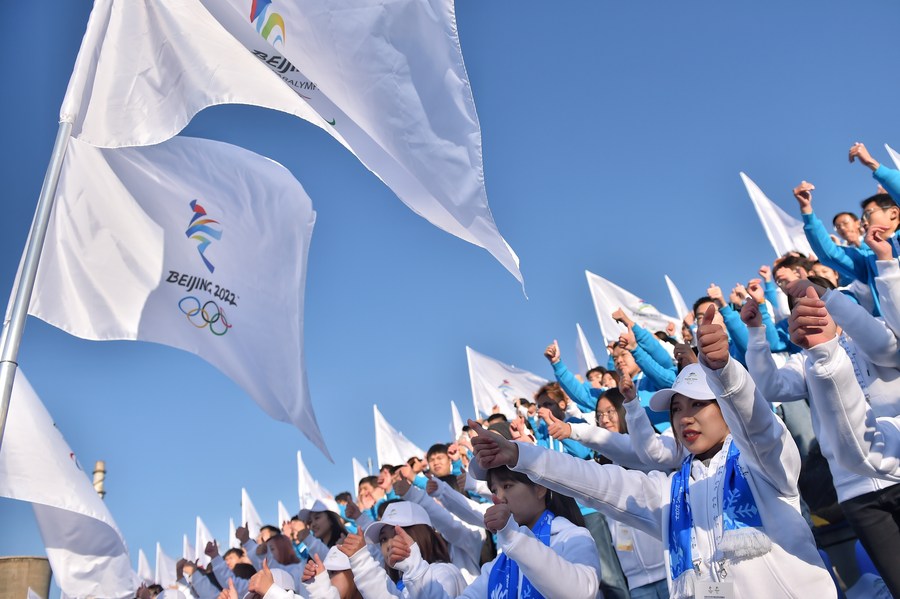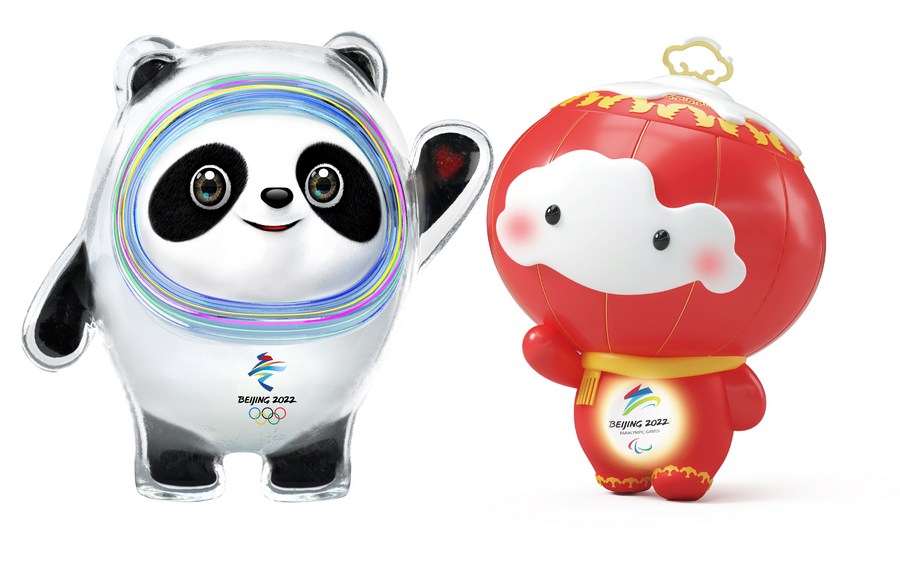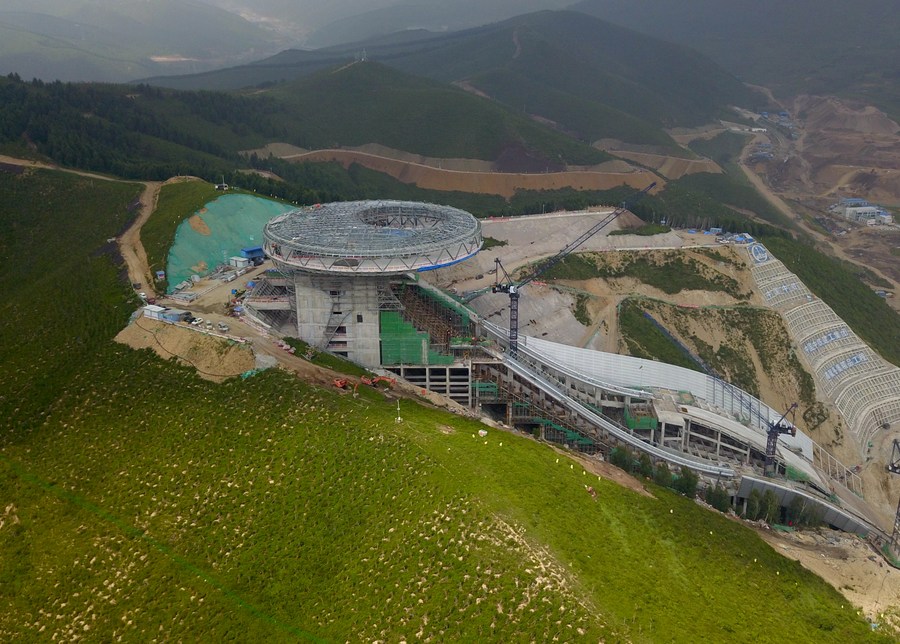With 500 days to go, Beijing's 2022 vision is taking shape
The COVID-19 pandemic has wreaked havoc on global sport this year, as a number of events were canceled or postponed, but China's preparations for the 2022 Winter Olympic Games remain on track without suffering any major delays.
The COVID-19 pandemic has wreaked havoc on global sport this year, as a number of events were canceled or postponed, but China's preparations for the 2022 Winter Olympic Games remain on track without suffering any major delays.
Beijing 2022 pledged to fulfil its commitment as it marked 500 days to go until the Games on Monday.
"The lead-up to the Olympic Games is just like running a marathon. We are now more than halfway through our journey but face an uphill battle ahead," Beijing 2022 vice-president and secretary-general Han Zirong told Xinhua in an exclusive interview.
"We will continue to work closely with the International Olympic Committee (IOC), the International Paralympic Committee (IPC) and other stakeholders to deal with challenges properly and ensure our preparatory work advances steadily."

Volunteer representatives attending the launch ceremony of the global recruitment of volunteers for the 2022 Olympic and Paralympic Winter Games in Beijing, Dec. 5, 2019. [Photo/Xinhua]
During the past month, top IOC officials, including president Thomas Bach, have praised the progress the Chinese organizers have made.
"We heard a very encouraging technical report from the Coordination Commission who informed us the technical preparations are on track and going very well," Bach said after an IOC executive boarding meeting.
Venue construction on schedule
The 2022 Winter Olympics will take place from February 4 to 20, 2022. Competitions are due to be staged in three main clusters - downtown Beijing, the capital's northwest Yanqing District and Zhangjiakou in neighboring Hebei Province.
Following a short break during the Spring Festival, Beijing 2022 organizers resumed venue construction work under vigilant virus prevention measures as early as February, laying a solid foundation for all 2022 competition venues, whether newly-built or renovated, to be ready by the end of this year.
With test events set to be held during the upcoming winter season, two of the new permanent venues have been completed, and organizers say construction of the remainder is proceeding as scheduled.
A highlight is the completion of a new indoor ice sports training center, dubbed the "Ice Jar", on May 27. The venue provides a training site for short-track speed skating and figure skating as an accompaniment to the Capital Gymnasium, where those two sports will be staged during the Games.
Built adjacent to disused cooling towers and smokestacks, which evoke Beijing's industrial past, the Big Air slope in the Shougang Industrial Park is the first newly-built venue that has been completed, and hosted the Air + Style FIS Snowboard World Cup last December.
The National Speed Skating Oval, locally known as the "Ice Ribbon" owing to the pattern included in its design, is the only major urban facility being built for the 2022 Winter Olympics. The main structure and roof of the building have already been finished and work is now focused on interior decorations and making ice.
Beijing 2022 will also make use of eight existing sites and two temporary venues. The decision to use so many existing venues - all but the "Bird's Nest" are currently undergoing renovation work - will help minimise construction costs and contribute to the sustainable legacy of the Olympic Games.
Key milestones met
The past few months have also witnessed a number of important milestones, such as the launch of a global competition for the official 2022 medal, torch and apparel designs. The IOC broadcasters' meeting and other important conferences were also held via video link.
Beijing 2022 has shortlisted 10 out of 193 proposals received for the medal design and the final design is expected to be unveiled early next year after receiving the nod from the IOC. Meanwhile, a group of experts is working on minor modifications to the torch design and its interior burning system.
In terms of marketing, a domestic sponsorship program was met with an extensive response. Beijing 2022 has attracted 34 sponsors and suppliers in total to date: 10 partners, 10 sponsors and 14 suppliers. Sales of Beijing 2022 licensed products have been picking up, with some Olympic merchandise likely to become collectibles.
Momentum is also building for volunteer recruitment. More than 870,000 people from China and overseas have applied to volunteer during the 2022 Olympic and Paralympic Games, in further evidence of the powerful legacy and spirit of volunteerism stemming from the 2008 Olympic Games.
Engaging with youth, a key goal of the Olympic Agenda 2020, has been put into practice by the local organizers and supported by the government at national and municipal levels.
The Olympic Values Education Program (OVEP) and I'mPOSSIBLE toolkit, created by the IOC and IPC respectively, are being distributed to over 1,800 schools across the country.
Several other legacy commitments have also come to fruition, including encouraging 300 million people to take part in winter sports.
Chinese culture showcase
Like previous Olympic hosts, Beijing has been exploring ways to bring together China's cultural and artistic powers to the Olympic stage.
As part of the celebrations of the 500-day milestone, Bing Dwen Dwen and Shuey Rhon Rhon, the mascots for the 2022 Olympic and Paralympic Winter Games, took on new looks featuring various colors to widen their appeal.

The mascot of Beijing 2022 Olympic Winter Games Bing Dwen Dwen (L) and the mascot of Beijing 2022 Paralympic Winter Games Shuey Rhon Rhon.
Through Bing Dwen Dwen, Beijing 2022 organizers say they want to convey a message of modesty, diligence and friendship that Chinese people show in endeavoring to contribute to the country's welfare and realizing their dreams.
Based on a traditional red lantern, Paralympic mascot Shuey Rhon Rhon creates the cheerful atmosphere of the Chinese Lunar New Year, which will fall around the time of the Winter Games.
The logo of Beijing 2022 has several multi-layered meanings. It is modeled after the Chinese character for "winter" and features the red and yellow colors of the Chinese national flag. It also features a blue ribbon that represents the mountains of China, as well as flowing forms that mimic the motion of skiers and the beauty of skaters.
Oriented around the Chinese character "fei" (fly), the Paralympic emblem is an abstract image of an athlete who is fighting for victory, highlighting the spirit of and inspiration for the Paralympic Winter Games.
Besides the mascots and logos, some of the 2022 Winter Games venues embody Chinese culture just as eloquently.

An aerial photo taken on July 30, 2020 shows the construction site of the National Ski Jumping Center in Chongli District of Zhangjiakou City. [Photo/Xinhua]
The 'S-type' curve of the National Ski Jumping Center, located in the Zhangjiakou competition zone, is nicknamed 'Snow Ruyi' thanks to its resemblance to the shape of a 'Ruyi', a traditional Chinese ornament symbolizing good luck. The Palace Museum has nearly 3,000 Ruyi scepters in a wide variety of materials.
Chief designer Zhang Li is proud of his team's idea. "In terms of making use of the terrain, the 'Snow Ruyi' design is a good example," said Zhang.
Looking ahead, the Beijing 2022 medals and torch designs will be unveiled in coming months. People have a good reason to expect that Chinese culture will also be demonstrated in their designs.

